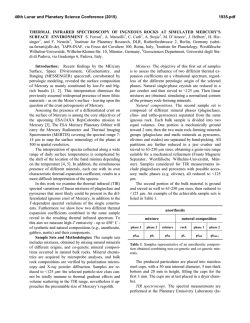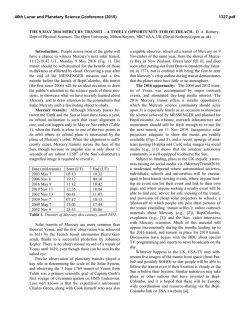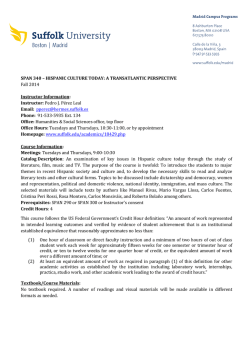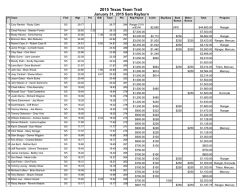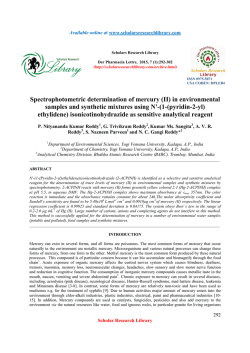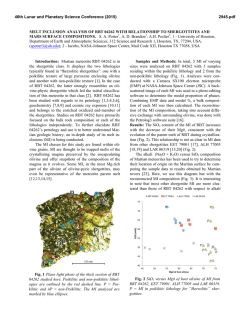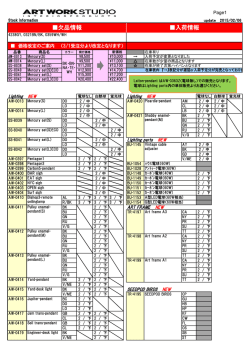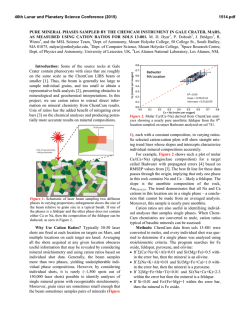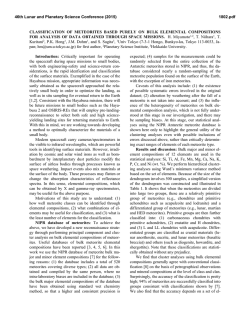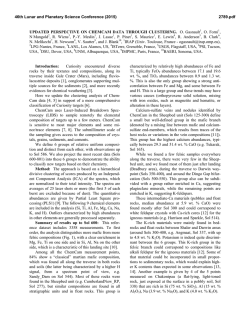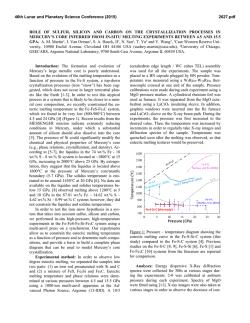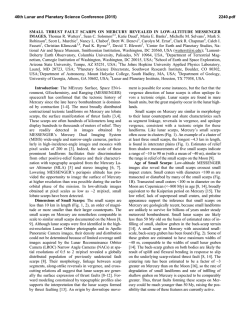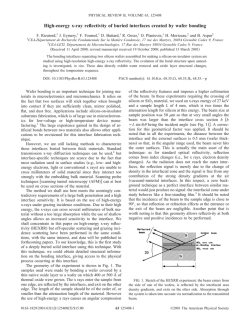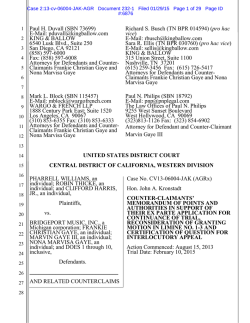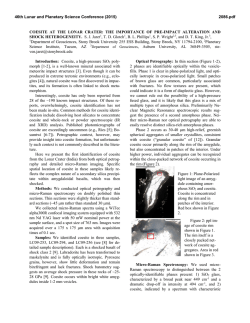
PETROLOGIC DIVERSITY OF ROCKS ON MERCURY. K. E. Vander
46th Lunar and Planetary Science Conference (2015) 1364.pdf PETROLOGIC DIVERSITY OF ROCKS ON MERCURY. K. E. Vander Kaaden1, F. M. McCubbin1, L. R. Nittler2, S. Z. Weider2. 1Institute of Meteoritics, 1 University of New Mexico, MSC03-2050, Albuquerque, NM 87131. 2Department of Terrestrial Magnetism, Carnegie Institution of Washington, Washington, DC 20015, ([email protected]). Introduction: The X-Ray Spectrometer (XRS) and Gamma-Ray Spectrometer (GRS) on board the MErcury Surface, Space ENvironment, GEochemistry, and Ranging (MESSENGER) spacecraft are providing the first detailed chemical analyses of Mercury’s surface [1–7]. Thus far, several geochemical terranes have been identified on the planet’s surface [8]. To investigate the petrologic diversity of rocks on the innermost planet we focus our study on nine regions with characteristic major element compositions [8]: (i) the high-Mg region (HMR), (ii) a sub-region of the HMR with the planet’s highest Ca and S contents (HMR-CaS), (iii) the smooth plains within the Caloris basin (CB), (iv) a subset of the northern volcanic plains (NP) with relatively high Mg content (NPHMg), (v) a subset of the NP with relatively low Mg content (NP-LMg), (vi) the Rachmaninoff basin (RB), (vii) the high-Al region southwest of the NP (HAl), (viii) the planet’s largest pyroclastic deposit, located northeast of the Rachmaninoff basin (PD), and (ix) the intermediate terrane (IT), made up of intercrater plains and highly-cratered terrain. To determine the composition of each region from the XRS-derived elemental ratios, the absolute abundance of Si is required. GRS measurements constrain Si, but with large uncertainty; regional variations on the order of 10–15%, relative, are permitted by the data [3]. In some previous MESSENGER studies [e.g., 1, 6, 8], an Si abundance of 25 wt%, which was calculated by first calculating O by stoichiometry and then renormalizing to 100%, has therefore been used. With this calculated Si abundance, however, the range of analytical totals for the different regions is large (83.85–110.10 wt%). Given the now well-established [e.g., 2–6, 8] geochemically heterogeneous nature of Mercury, it is likely that Mercury’s Si abundance is similarly variable across the surface. It is therefore our goal to determine an average composition for each of these regions and to provide petrologic classifications for the rocks that likely constitute Mercury’s surface. These data will provide insight into the petrologic diversity of rocks on the planet, as well as the range in Si (or SiO2) abundances across the surface. Methods: We have used recent XRS [1, 8] and GRS [2, 3] analyses to determine average compositions for nine geochemical regions (see Table 1). Importantly, the abundances of Ti, Mn, and Cr have not been reported for most of these units; therefore we calculated two average compositions for each geochemical unit. For the first composition only reported values of Ti, Mn, and Cr were used (when available). For the second set of average compositions (Table 1), we used the XRS detection limits for Ti, Mn, and Cr [1] as the upper limit concentrations of these elements in each region. To determine the composition of each distinct geochemical region, we first assigned the valence of each element (i.e., Si4+, Ti4+, Al3+, Cr3+, Fe2+, Mn2+, Mg2+, Ca2+, Na+, K+, S2-). We then calculated a corresponding abundance of O2so that the resulting composition for each region was charge balanced. If no major constituent elements have been excluded, the resulting sum of oxides/sulfides should be ~100 wt%. We therefore normalized the composition of each region to 100 wt%, while maintaining the measured element/Si ratios. The resulting compositions are presented in Table 1. Results: Before each region’s composition was normalized to 100 wt% (i.e., by using 25 wt% Si, for compositions that both contained and were free of Ti, Cr, and Mn), the analysis totals exhibited ranges of 104.38–107.01 wt% (HMR), 107.48–110.10 wt% (HMR-CaS), 90.95–92.33 wt% (CB), 93.50– 96.13 wt% (NP-HMg), 83.85–86.48 wt% (NP-LMg), 100.97–103.60 wt% (RB), 101.06–103.69 wt% (HAl), 101.37–104.00 wt% (PD), and 101.23–103.86 wt% (IT). After our normalization, there is a range of ~6.4 wt% Si, which corresponds to a range of ~13.7 wt% SiO2 across the nine regions. This range (standard deviation of 8% relative) is consistent with the GRS measurements [3]. Using the SiO2 and total alkali contents of each composition, the petrologic classification of each composition is shown on a TAS diagram in Figure 1. This diagram, however, is not directly applicable to our compositions, i.e., with high MgO contents >8 wt%. To place further constraints on the classification of the distinct geochemical regions, we have therefore used the high-Mg classification diagram, which we have superimposed on the TAS diagram in Figure 1. Both NP regions, as well as the CB, can be classified as boninites since their SiO2 and MgO contents are >52 wt% and 8 wt%, respectively. This classification system was constructed for terrestrial systems, and the total alkali content only extends to 4 wt% (Na2O + K2O). Thus, we use the term ‘alkali-rich boninite’ for compositions with ≥4 wt% total alkalis (e.g., NP-HMg, NP-LMg, CB). Both of the HMR regions can be classified as komatiitic since their SiO2 contents are <52 wt% and their MgO contents are >18 wt%, although they may not be komatiites sensu stricto, if future targeted analyses are in agreement with the current latitude binning of [2] which suggests these regions may have >1 wt% Na2O. The remaining 46th Lunar and Planetary Science Conference (2015) 1364.pdf Table 1. Average compositions (wt%) for nine distinct geochemical units on Mercury. Unless otherwise indicated, analyses are from XRS measurements [4, 8]. *K values from “all 2012” data in [3], except where targeted analyses were available. Na values for a0–60°N, baverage of 15–30°N and 30–45°N, c75–90°N, daverage of 45–60°N and 60–75°N, and e30–45°N [2]. HMR HMR-CaS CB NP-HMg NP-LMg RB HAl PD IT 49.97 48.57 57.93 55.64 61.87 51.62 51.58 51.42 51.49 SiO2 25.04 26.17 12.86 17.23 11.41 24.95 18.90 21.13 20.84 MgO 6.32 7.58 5.87 5.10 5.56 4.88 6.26 7.23 5.62 CaO 9.65 8.82 15.50 12.32 10.73 11.69 15.37 11.35 13.69 Al2O3 0.16 0.16 0.09 0.22 0.22 0.16 0.16 0.16 0.11 *K2O 3.46a 3.36a 4.03b 6.03c 4.52d 3.60b 4.00e 3.99e 3.47a Na2O 1.84 1.61 0.97 0.00 1.71 0.00 0.00 1.92 1.55 FeO 1.17 1.14 0.45 1.30 1.45 1.21 1.21 1.20 1.20 TiO2 0.68 0.66 0.79 0.76 0.85 0.71 0.70 0.70 0.70 Cr2O3 0.60 0.59 0.70 0.67 0.75 0.62 0.62 0.62 0.62 MnO 2.21 2.71 1.58 1.46 1.90 1.13 2.40 0.55 1.37 S 1.10 1.35 0.79 0.73 0.95 0.57 1.20 0.28 0.68 -O=S 100.00 100.00 100.00 100.00 100.00 100.00 100.00 100.00 100.00 Total 23.36 22.70 27.08 26.01 28.92 24.13 24.11 24.04 24.07 Wt% Si Total assuming 107.01 110.10 92.33 96.13 86.48 103.60 103.69 104.00 103.86 25 wt% Si regions (e.g., RB, HAl, PD, and IT) span these two distinct compositions and can be classified as either boniniitic or komatiitic, depending on the amount of SiO2 and MgO present. Figure 1. Total alkali versus silica diagram for nine distinct geochemical units on Mercury. Shaded region >52 wt% SiO2 represents boninites. Unshaded region <52 wt% SiO2 represents komatiitic compositions. Both the constituent NP lava flows and the PD likely represent melt compositions, so we have provided additional information regarding the geochemical properties of these melts in Table 2. Table 2. Silicate melt parameters for three distinct volcanic units. M: Metaluminous. NBO/T: Nonbridging oxygen per tetrahedrally coordinated cation. NP-HMg NP-LMg PD Alumina M M M Saturation 100 92.2 95.15 Mg # Alkalinity 0.82 0.72 0.59 Index 0.85–0.88 0.61–0.64 1.18–1.20 NBO/T Discussion: Our results indicate that Mercury has a diverse set of rocks on its surface. From our investigation, we infer a wide range of SiO2 content, alkali content, and major element compositions across Mercury’s surface. Our petrologic classification of the nine geochemical regions indicates that Mercury’s surface is chemically evolved relative to those of the Moon and Mars, and is similar (with respect to SiO2 content) to Earth [9]. In fact, Mercury may represent the only other example of a planet in our Solar System with vast amounts of andesitic crust exposed at the surface. The formation of Earth’s evolved crust is normally associated with plate tectonics and the presence of water. These two factors, however, were likely not involved with the formation of Mercury’s crust. The study of Mercury’s crustal composition may therefore provide important new insights into crustal evolution mechanisms. Our results also have important implications for the interpretation of MESSENGER XRS and GRS data. In the past, elemental abundances have been calculated from the ratio to Si, by using a fixed, calculated Si value of 25 wt%. The wide range in Si content that we find, however, implies that this practice could be problematic. References: [1] Nittler L. R. et al., (2011) Science, 333, 1847-1850. [2] Peplowski P. N. et al., (2014) Icarus, 228, 86-95. [3] Peplowski P. N. et al. (2012) JGR: Planets, 117, E00L04. [4] Nittler L. R. et al. (2014) LPS XLV, #1391 [5] Weider S. Z. et al. (2014) Icarus 235, 170-186. [6] Weider S. Z. et al. (2012) JGR: Planets, 117, E00L05. [7] Evans L. G. et al. (2012) JGR: Planets, 117, E00L07. [8] Weider S. Z. et al. (2015) EPSL, in review. [9] Taylor S. R. and McLennan S.M. (2009) Planetary Crusts: Their Composition, Origin, and Evolution, Cambridge, pp. 378.
© Copyright 2025

